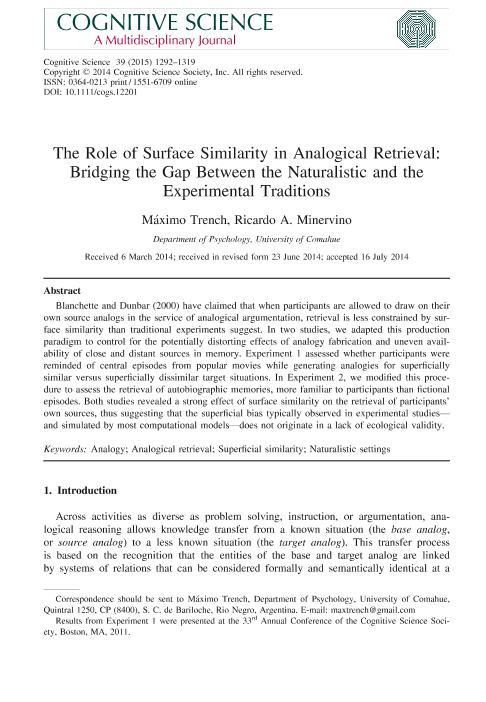Artículo
The Role of Surface Similarity in Analogical Retrieval: Bridging the Gap Between the Naturalistic and the Experimental Traditions
Fecha de publicación:
11/2014
Editorial:
Wiley
Revista:
Cognitive Science
ISSN:
0364-0213
Idioma:
Inglés
Tipo de recurso:
Artículo publicado
Clasificación temática:
Resumen
Blanchette and Dunbar (2000) have claimed that when participants are allowed to draw on their own source analogs in the service of analogical argumentation, retrieval is less constrained by surface similarity than traditional experiments suggest. In two studies, we adapted this production paradigm to control for the potentially distorting effects of analogy fabrication and uneven availability of close and distant sources in memory. Experiment 1 assessed whether participants were reminded of central episodes from popular movies while generating analogies for superficially similar versus superficially dissimilar target situations. In Experiment 2, we modified this procedure to assess the retrieval of autobiographic memories, more familiar to participants than fictional episodes. Both studies revealed a strong effect of surface similarity on the retrieval of participants' own sources, thus suggesting that the superficial bias typically observed in experimental studies-and simulated by most computational models-does not originate in a lack of ecological validity.
Archivos asociados
Licencia
Identificadores
Colecciones
Articulos(CCT - PATAGONIA NORTE)
Articulos de CTRO.CIENTIFICO TECNOL.CONICET - PATAGONIA NORTE
Articulos de CTRO.CIENTIFICO TECNOL.CONICET - PATAGONIA NORTE
Citación
Minervino, Ricardo Adrian; Trench, Juan Maximo; The Role of Surface Similarity in Analogical Retrieval: Bridging the Gap Between the Naturalistic and the Experimental Traditions; Wiley; Cognitive Science; 39; 6; 11-2014; 1292-1319
Compartir
Altmétricas




